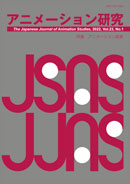Volume 23, Issue 1
Displaying 1-16 of 16 articles from this issue
- |<
- <
- 1
- >
- >|
-
2023Volume 23Issue 1 Pages 1
Published: January 31, 2023
Released on J-STAGE: February 11, 2023
Download PDF (215K)
Special Article
-
2023Volume 23Issue 1 Pages 3-13
Published: January 31, 2023
Released on J-STAGE: February 11, 2023
Download PDF (644K)
Invited Special Articles
-
2023Volume 23Issue 1 Pages 15-27
Published: January 31, 2023
Released on J-STAGE: February 11, 2023
Download PDF (716K) -
2023Volume 23Issue 1 Pages 29-40
Published: January 31, 2023
Released on J-STAGE: February 11, 2023
Download PDF (468K)
Special Research Note
-
2023Volume 23Issue 1 Pages 41-46
Published: January 31, 2023
Released on J-STAGE: February 11, 2023
Download PDF (443K)
Invited Special Research Note
-
2023Volume 23Issue 1 Pages 47-51
Published: January 31, 2023
Released on J-STAGE: February 11, 2023
Download PDF (515K)
Articles
-
2023Volume 23Issue 1 Pages 53-66
Published: January 31, 2023
Released on J-STAGE: February 11, 2023
Download PDF (637K) -
2023Volume 23Issue 1 Pages 67-75
Published: January 31, 2023
Released on J-STAGE: February 11, 2023
Download PDF (675K) -
2023Volume 23Issue 1 Pages 77-87
Published: January 31, 2023
Released on J-STAGE: February 11, 2023
Download PDF (984K) -
2023Volume 23Issue 1 Pages 89-100
Published: January 31, 2023
Released on J-STAGE: February 11, 2023
Download PDF (1325K) -
2023Volume 23Issue 1 Pages 101-113
Published: January 31, 2023
Released on J-STAGE: February 11, 2023
Download PDF (875K) -
2023Volume 23Issue 1 Pages 115-122
Published: January 31, 2023
Released on J-STAGE: February 11, 2023
Download PDF (620K)
Reports
-
2023Volume 23Issue 1 Pages 123-124
Published: January 31, 2023
Released on J-STAGE: February 11, 2023
Download PDF (283K) -
2023Volume 23Issue 1 Pages 125-155
Published: January 31, 2023
Released on J-STAGE: February 11, 2023
Download PDF (3082K)
-
2023Volume 23Issue 1 Pages 157-160
Published: January 31, 2023
Released on J-STAGE: February 11, 2023
Download PDF (468K) -
2023Volume 23Issue 1 Pages 166
Published: January 31, 2023
Released on J-STAGE: February 11, 2023
Download PDF (300K)
- |<
- <
- 1
- >
- >|
